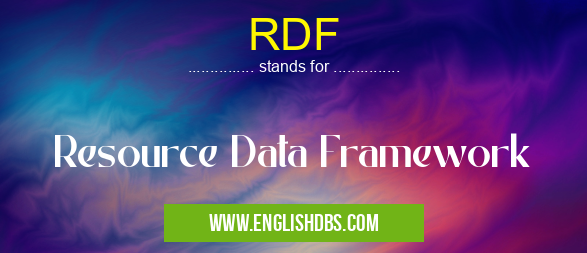What does RDF mean in UNCLASSIFIED
RDF (Resource Description Framework) is a W3C standard for representing and exchanging data on the Web. It is a framework for describing resources (anything that can be identified on the Web) and their relationships to each other. RDF is used to create and share structured data in a way that is both machine-readable and human-readable.

RDF meaning in Unclassified in Miscellaneous
RDF mostly used in an acronym Unclassified in Category Miscellaneous that means Resource Data Framework
Shorthand: RDF,
Full Form: Resource Data Framework
For more information of "Resource Data Framework", see the section below.
What is RDF?
RDF data is typically stored in XML, but it can also be stored in other formats such as JSON, Turtle, and RDFa.
RDF is based on the idea of triples. A triple is a subject-predicate-object statement that describes a relationship between two resources. For example, the triple "Jane Doe is a professor at MIT" describes the relationship between the subject Jane Doe and the object MIT, which is mediated by the predicate is a professor at.
How RDF Works
RDF data is organized into graphs. A graph is a collection of triples that are connected to each other. The nodes in the graph represent resources, and the edges represent the relationships between the resources.
RDF graphs can be used to represent a wide variety of data, including:
- People and their relationships: RDF can be used to represent people, their relationships to each other, and their attributes.
- Products and their availability: RDF can be used to represent products, their availability, and their prices.
- Events and their schedules: RDF can be used to represent events, their schedules, and their locations.
Benefits of Using RDF
There are many benefits to using RDF, including:
- RDF is a flexible framework: RDF can be used to represent a wide variety of data, making it a versatile tool for data exchange.
- RDF is extensible: RDF can be extended with new vocabularies to represent new types of data.
- RDF is interoperable: RDF data can be shared and exchanged between different applications and systems.
- RDF is machine-readable: RDF data can be processed by machines, making it easier to automate data processing tasks.
Essential Questions and Answers on Resource Data Framework in "MISCELLANEOUS»UNFILED"
What is the Resource Description Framework (RDF)?
RDF is a W3C standard framework for representing data as a set of triples, where each triple consists of a subject, predicate, and object. It provides a way to describe resources and the relationships between them, making it a useful tool for data integration and exchange.
What is the purpose of RDF?
RDF's primary purpose is to provide a structured and interoperable way to represent data on the web. It allows for the creation of knowledge graphs and ontologies, which can be used to represent information in a logical and meaningful way. This enables data from different sources to be combined and queried, facilitating data integration and analysis.
What are the key components of RDF?
RDF is composed of three main components:
- Resources: Entities or objects about which data is described.
- Properties: Attributes or relationships that connect resources.
- Statements: Triples that consist of a resource, property, and value, representing facts or assertions about the data.
What is the difference between RDF and XML?
While both RDF and XML are used for data representation, they differ in their approaches. RDF focuses on representing data as a network of interlinked triples, while XML uses a hierarchical tree structure. RDF is more flexible and expressive, allowing for easier data integration and querying.
What are the advantages of using RDF?
Using RDF offers several advantages:
- Interoperability: RDF enables seamless data integration from various sources, regardless of their original format or structure.
- Flexibility: RDF's triple-based structure allows for easy data manipulation and extension, accommodating new information and relationships as needed.
- Extensibility: RDF's extensibility allows the creation of vocabularies and ontologies, enabling the precise and tailored representation of data in specific domains.
What are the limitations of RDF?
Despite its advantages, RDF also has some limitations:
- Data Size: RDF storage and processing can become resource-intensive when dealing with large datasets.
- Complexity: Understanding and managing RDF graphs can be challenging, especially for those unfamiliar with its underlying concepts.
- Query Performance: Querying large RDF datasets can be computationally expensive, requiring specialized optimization techniques.
Final Words: RDF is a powerful framework for representing and exchanging data on the Web. It is a flexible, extensible, interoperable, and machine-readable format that can be used to represent a wide variety of data. RDF is a valuable tool for data integration, data sharing, and data analysis.
RDF also stands for: |
|
| All stands for RDF |
